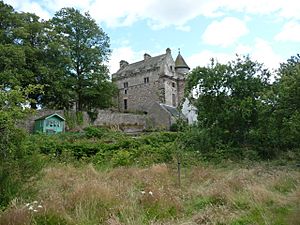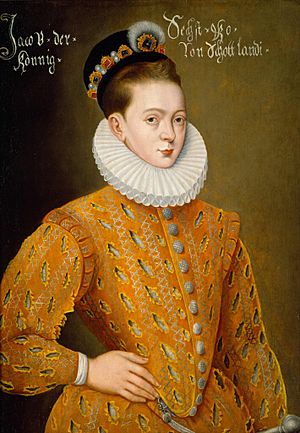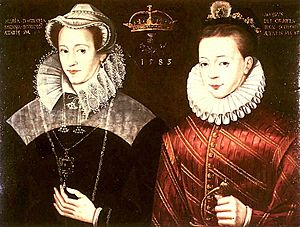Albert Fontenay facts for kids
Albert Fontenay was a French helper and diplomat for Mary, Queen of Scots. He worked for her in Scotland in 1584. Fontenay wrote a famous description of the young King James VI of Scotland. Some of his letters to Mary, Queen of Scots, were decoded and published later.
Fontenay was an important administrator for Mary. He managed her estates and money in France. James Beaton, a supporter of Mary, helped with her French affairs. Fontenay was related to other people working for Mary. He was often called the half-brother or brother of Mary's secretary, Claude Nau. Nau would call Fontenay "Albert" in his letters.
Contents
Fontenay's Travels and Work
In 1577, Claude Nau wrote from England about Mary's finances. He hoped Fontenay might get a job managing Mary's money. Fontenay visited Mary in England in 1582. She decided to send him as a diplomat to Spain. In 1585, he mentioned buying valuable perfumes in Spain.
Fontenay later said he arrived with his brother-in-law, Jean de Champhuon. They came to see Mary in England in 1582. They found she was out hunting. Champhuon went to London and met Francis Walsingham.
Diplomatic Mission to Scotland in 1584

Fontenay traveled to Scotland as Mary's diplomat in July 1584. At this time, Mary was a prisoner in England. He brought Mary's ideas for her return to Scotland. She hoped to become a joint ruler with her son, James VI. This plan was called the "association".
Fontenay arrived in Leith on July 4. A few days later, he sent a message to James VI. The king was at Falkland Palace. James sent James Stewart, 1st Lord Doune to meet Fontenay. An English diplomat heard Fontenay brought a sword for the king. It was a gift from Mary.
James VI welcomed Fontenay to Falkland Palace. Fontenay gave James Mary's sword. They had a friendly talk. James said he had been Mary's knight since he was a baby. He even started wearing a diamond cross. This might have been to honor his mother.
King James's Hobbies and Politics
James lent Fontenay a horse to follow the hunt. James loved hunting best. He would spend six hours riding. He said looking at royal accounts made him sick. Fontenay thought other nobles encouraged James to play. This way, they could hold the real power. These nobles included the Earl of Arran and Secretary Maitland.

James wrote to Mary in French on July 23, 1584. He was happy to welcome Fontenay. He understood Fontenay wanted to talk about their "perfect union". James said he would discuss it after Lord Seton returned from France. Fontenay also had other secret messages for James.
The Young Old Man
On August 15, Fontenay wrote about James VI. He said James was smart and well-educated. But he was also shy and lacked court manners. Fontenay thought James did not know how poor the Scottish crown was. He believed James chose bad friends at court. James seemed more interested in hunting than his royal duties. Fontenay called him a "young old man". This meant James avoided his political work.
Fontenay tried to convince James to make a deal with his mother. James later saw a letter from Mary to Fontenay. It said if James did not agree, he would only get the Lordship of Darnley.
Fontenay's letters were written in code. He found it hard to write and code them. He needed help. His descriptions of James were not always right. For example, he said James disliked dancing and music. But records show James took dance lessons. He also supported musicians.
Building Support for Mary
Fontenay was invited to a dinner at Edinburgh Castle. The Earl and Countess of Arran hosted it. Fontenay joked that Scottish food made him sick. This made James blush and smile. Fontenay wrote about this to Mary. He said the Arrans tried to convince James that Mary would replace him. They did not want Mary to form a partnership. They worried Mary might marry again and have another heir if she was freed.
Fontenay met Agnes Keith. She was happy to hear news from Mary. Fontenay liked her because she spoke of her love for Mary. He also met Margaret Fleming, Countess of Atholl, another ally of Mary.
Fontenay described his talks with Arran as a joke. Arran seemed to threaten him, then offered him a diamond. Fontenay gave Arran Spanish leather. James used Lord Seton's letter as an excuse not to move forward. Fontenay felt his mission was failing.
Authorities in Edinburgh seized Fontenay's luggage. They thought it had forbidden Catholic books. James ordered his "cofferis and guids" returned. But James did not ask Fontenay about his mother's life in England. It became clear James and his advisors would not support the "association". They also did not support Mary's plan to invade England. This plan was called the "Enterprise of England". James worried it would not benefit him.
Fontenay and the Master of Gray
The Master of Gray, a Scottish diplomat, became angry. Fontenay seemed to have shown King James a letter from Mary. The letter said Gray was not trustworthy. Fontenay had also written to Mary that he did not trust Gray. He believed Gray shared Mary's letters with Elizabeth I.
Francis Walsingham heard about this argument in December 1584. Nau was in London, but Gray would not work with him. Gray told Elizabeth that Fontenay was a bigger liar than his brother Nau.
Elizabeth knew there was no treaty between James and Mary. Mary was upset with Gray. She thought he was working for her. But he was now only working for her son. Gray said Fontenay was asked to leave Scotland in January 1585. Before leaving, Fontenay claimed Gray had sworn to kill the Earl of Arran.
Fontenay did not leave Scotland quickly. James gave him a letter for Mary in late February. Fontenay's departure was delayed. He wrote a letter to Mary on March 9, 1585. He criticized the Earl and Countess of Arran. He wrote that the Countess had "bewitched" the king. He also warned Nau about a rumor. The rumor was that Mary made Nau sleep with her. So, they should be careful when the Master of Gray visited.
James gave Fontenay another letter at Holyrood Palace on March 15, 1585. James sent Lord Doune with a gift for Fontenay. It was a silver cup. Fontenay refused it as a matter of honor.
After Fontenay left Scotland, Lady Margaret Fleming wrote to Mary. She thanked Mary for the letter Fontenay brought. She said Fontenay was a "faithful servitor" to Mary. She felt he was not rewarded enough in Scotland.
Mary's Supporters and Conspirators
Fontenay sent a box to Paris from Scotland. His brother-in-law, Jean de Champhuon, found a secret part. It had letters supposedly from James VI to Mary and her allies. Thomas Morgan wrote to Mary about this discovery. Morgan's letter was stopped and decoded.
Fontenay planned to marry the eldest daughter of Monsieur Masuyer. Masuyer was a well-connected lawyer in Paris. Fontenay had liked her since 1583. Fontenay's family supported the marriage.
Claude Nau advised Fontenay to avoid political groups in France. He told him to speak well of James VI. Nau wrote about buying a wedding present. In July 1585, Claude Nau wrote that he had ended his own engagement. This would help his career. A letter from the French ambassador said Fontenay had stopped working for Mary in England. He had found work in France.
Thomas Morgan introduced Fontenay to Charles Paget. They met Claud Hamilton in Paris in January 1586. Fontenay gave Hamilton a secret code alphabet. Paget wrote to Mary and Nau. He mentioned Fontenay's "great comfort and friendship". Mary wanted Fontenay to keep her updated on her dowry. She asked him to write often. She agreed not to use him for state affairs.
In May 1586, Gilbert Curle, Mary's secretary, wrote that Fontenay was ready to help. Claude Nau wrote in July 1586. He said Fontenay had not been a diplomat for Mary recently. Fontenay's visit to Spain had made the French king suspicious. So, he had to stop foreign negotiations. Paget wrote that Fontenay was discouraged by the Archbishop of Glasgow.
Mary asked the French ambassador to get permission for Fontenay to serve her in England. This was in August 1586. She seemed to trust Fontenay more than others. After her death sentence in November 1586, she missed him. She blamed Nau and Pasquier for betraying her secrets. She wrote that Fontenay was a strong and knowledgeable young man.
The "Enterprise of England" happened as the Spanish Armada in 1588.


